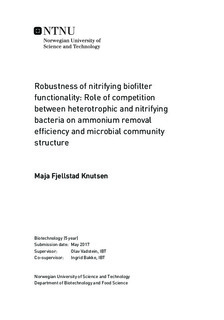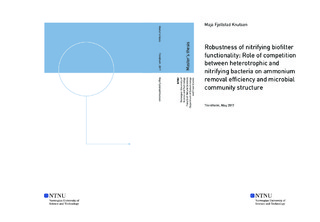| dc.description.abstract | Removal of ammonium by nitrification in biofilm systems is a common method in wastewater treatment. The ammonium removal efficiency in the nitrification process is influenced by the competition between nitrifying bacteria and heterotrophic bacteria in the biofilm, particularly for space and oxygen. The competition is affected by the ratio of organic carbon (C) to inorganic nitrogen (N) in the wastewater, since organic carbon gives advantageous conditions for the heterotrophic bacteria that can outcompete the nitrifying bacteria in the biofilm. The aim for this master thesis was to improve the knowledge about the competition between nitrifying and heterotrophic bacteria in the biofilm in order to improve ammonium removal efficiency and functionality. Experiments were done in two different nitrification biofilm systems.
The first nitrification system investigated was for biofilm carriers in moving bed biofilm reactors (MBBR) at the Department of Biotechnology. The hypothesis behind the MBBR experiments was that the biofilm with long-term exposure to organic loading (C/N ratio 1) would have reduced nitrification robustness and nitrification efficiency because of increased heterotrophic growth compared to biofilm without long-term exposure to organic loading (C/N ratio 0). Two MBBR were continuous operating for 2 separate periods of time and different short-term experiments were done to investigate the differences between the reactors.
The results from the long-term continuous operations were that nitrification activity and stability, and thus nitrification efficiency, were not decreased after long-term supply of C/N ratio 1 to the biofilm. Acute organic carbon inhibition experiments showed decreased nitrification efficiency in the biofilm with long-term exposure to organic loading. Increased loading rate of organic carbon reduced the nitrification efficiency in both the reactors and denitrification was observed. Denaturing gradient gel electrophoresis (DGGE) showed a shift in microbial community structure after increasing the organic carbon concentrations in both reactors.
The second nitrification system investigated was stationary biofilters consisting of Leca in Biological Filtration and Oxygenated Reactors (BIOFOR) at Vestfjorden Avløpselskap (VEAS) wastewater treatment plant in Asker. The hypothesis behind the study of the stationary nitrification filters consisting of Leca particles was that the automatic washing process of the biofilters removed high amounts of heterotrophic bacteria from the outer layers of the biofilm, but not high amounts of the nitrifying bacteria in the inner layers of the biofilm.
The results from the batch oxygen experiments showed that oxygen consumption was 4 % higher and ammonium consumption rate was 19 % lower in unwashed biofilter compared to washed biofilter. The difference in ammonium consumption is a strong indication that the washing process remove heterotrophic bacteria. The DGGE analysis of microbial community structure showed that the difference between unwashed and washed biofilter was not statically significant. | |

